BRIEF FROM SUSTAINABLE DEVELOPMENT
TECHNOLOGY CANADA
Improving Canada’s Competitive Advantage
in the Clean Energy and Natural Resources Sectors
Executive Summary
Canada is privileged to have an abundance of natural resources. These resources are in demand globally, especially among emerging economies as they use raw materials and energy to build their infrastructure and power their development. As a country with a strong reputation for innovation, Canada has the opportunity to apply some of its intellectual property to its natural resources, thereby maximizing the value and returns from those natural resources as well as expanding the work pool from beyond the resource extraction jobs to higher paying knowledge worker jobs in Canada. Cleantech offers the opportunity to combine innovation with Canada’s natural resource wealth and will position Canada to capitalize on strong export markets while maximizing the value of those natural resources.
Clean technology is emerging as a key dimension of the global economy given its potential to create new revenue streams, and provide efficiencies that save money, leading to higher profitability and competitiveness. This improved productivity, with new or better ways of producing goods, has the potential to revitalize industries, boost profitability and simultaneously improve businesses’ environmental performance. The world’s emerging economies are demanding these superior technologies to sustain their rapid growth, producing a cleantech market pegged at $4 trillion.
The challenge for Canada, with a relatively small domestic market, a high proportion of SMEs, and a dependence on exports for a large part of our economic growth, is how to capitalize on this unprecedented opportunity for Canadian business. This report describes a solution: the Canadian Cleantech Accelerator Fund™ (CCAF), which will help attract billions of private-sector dollars to the economy and create jobs that cannot be easily “off shored” like many manufacturing jobs have been in the recent past. The CCAF has been designed to minimize negative impacts on the budget deficit, while helping sustain economic recovery and the creation of sustainable jobs.
Growing Economic Prosperity through Cleantech
Maximize returns from Canada's natural resources. There is a growing demand for natural resources both domestically and globally, and it is taking more energy to extract these resources and supply them to the world market than ever before. Canada’s economy depends on being competitive in this world market - 70% of our GDP comes from exports. To remain competitive, Canada needs to be more efficient in the processing of its precious natural resources. We need to find ways to increase the value of these global commodities by moving up the value chain driven by the creation of new products and services. Further, available clean water, whether for drinking, industrial and agricultural processes is a fundamental resource under threat to which the application of clean technologies can make a real contribution.
The clean technology sector helps to create quality sustainable jobs. Canadian and US studies have demonstrated that the cleantech sector is a strong source for preserving or creating higher paying knowledge-worker jobs. A recent study from British Columbia shows that there are over 8,400 persons employed in developing clean technology and that number could soon grow to over 25,000. A similar Ontario study identifies 65,000 persons employed in cleantech and the environment sector. Through SDTC’s projects Canadian sawmill workers now operate biofuel plants; landfill workers now make electricity; auto parts makers now make nanomaterials-based components; metallurgists now make the primary ingredient for solar panels. SDTC has helped upgrade and preserve jobs in key Canadian economic sectors by transforming them with clean technologies.
Clean technologies provide a competitive edge for Canadian business. By definition clean technologies are more efficient, require fewer inputs and create novel outputs. Widespread uptake of clean technologies results in increased productivity for less cost - ultimately delivering greater profits and more competitive businesses. Additionally, the end product is often of a higher quality.
Cleantech mobilizes significant domestic and foreign private-sector investment. SDTC has succeeded in extensively engaging with investors resulting in the mobilization of significant levels of private-sector investment into cleantech (see SDTC’s market transformation results below). SDTC’s portfolio companies have leveraged each dollar of SDTC funding with more than $2.40 of third-party funding, attracting over $1 billion from the private-sector to their projects. In addition, some of SDTC’s more mature projects, have attracted a further $1.7 billion in follow-on funding, with over half of that amount coming from foreign sources. When more of the portfolio matures and those companies enter the market as well, they are expected to raise capital in excess of $4 billion.
SDTC has Helped Transform Canada’s Cleantech Sector
SDTC was created by the federal government to build a cleantech infrastructure in Canada, and has been at the forefront of spurring cleantech innovation, jobs and revenue. SDTC is in the business of helping commercialize clean technology innovation such that the private sector can pick up these technologies, take them to market (deployment) and deliver economic, environmental and health benefits to Canadians. Today, our SD Tech Fund™ is supporting 223 development and demonstration (D&D) projects in rural and urban communities across Canada with a portfolio value of $1.9 billion.
SDTC has been a significant contributor in building the Canadian cleantech sector in the public market. In 2008, the TSX sought out SDTC’s guidance, as a recognized cleantech authority to assist in the process of defining and establishing a cleantech sector for public listings. Joint events between TSX and SDTC to promote the cleantech sector to investors (TSX-SDTC Cleantech Investor Day) across Canada continue to be critical to establishing the credibility of this sector with a wide range of public market investors. Today, the TSX has the largest number of cleantech listings of any exchange globally and boasts the highest analyst coverage in the space. SDTC’s influence in the public markets is clear: in 2010, SDTC backed companies accounted for 28% of the Canadian cleantech listings on the senior market and just over 30% of new cleantech listings on the Venture exchange. A recent $100 million Initial Public Offering (IPO) by EcoSynthetix, an SDTC portfolio company, on the Toronto Stock Exchange is the largest Canadian cleantech IPO for 2011.
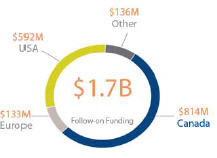
SDTC has attracted Foreign Direct Investment (FDI). 51% of the follow-on funding that SDTC supported companies have raised has come from foreign investors by way of long-term, value-added participation and joint venturing. This is well above the average of 34% FDI for Canadian venture funding. The SDTC team has worked extensively to achieve this higher ratio of foreign investment which has provided robustness to sustain companies in Canada and preserved jobs even in challenging economic times.
SDTC-supported companies outperform the market by a factor of four. The actual Compound Annual Growth Rate (CAGR) for SDTC supported companies is 113% or almost four times greater than that of other Canadian cleantech companies, according to a 2010 national cleantech study. Currently, SDTC ha s five companies with the potential to reach $10 0 million in annual re venue by 2020. The SDT C “20 by 2020” inspirational goal intends to grow this pool to 20 companies with $100 million revenue each.
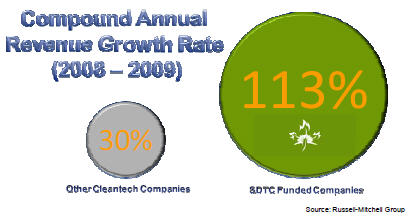
SDTC helps SMEs commercialize their clean technology driving innovation and creating wealth. Small and Medium-sized Enterprises (SMEs are an important part of the Canadian economy: they employ two-thirds of Canada’s workforce, account for 23% of Canada’s GDP and are responsible for 37% of all new jobs. Over 90% of SDTC’s portfolio is led by SMEs.
SDTC has achieved the highest leverage of public monies from private sector sources. In SDTC's funding model, one third of the funds to support a technology development and demonstration (D&D) project comes from the federal government and two thirds comes primarily from the private sector. This creates a first level of leveraging at 2.4 times the public funding.
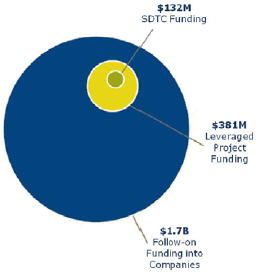
In addition the most mature companies/ technologies which have either completed their SDTC projects or are soon to complete have been aided by SDTC's follow-on funding efforts. SDTC understands how to create investment opportunities for the private sector SDTC’s market-maker role in stimulating equity investment is clear 43 of SDTC’s portfolio companies have attracted over $1.7 billion in follow-on private sector funding over the last 6 years. This creates a second level of leveraging, with a leverage multiplier of ten times.
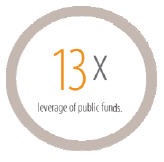
Combine these two levels of leveraging and it results in a "Times Thirteen" multiplier of public funds primarily from private-sector funds.
Cleantech can Sustain Canada’s Jobs and Economic Recovery
The clean technology sector is increasing the competitiveness and profitability of many of Canada’s traditional resource sectors such as forestry, mining and agriculture, contributing to their revitalization and protecting jobs in those sectors. SDTC also assists some of the traditional sectors, such as the oil & gas sector, obtain a social license to operate by greening the extraction and production of their natural resource. Further, the cleantech sector biomanufacturing and nanotechnology.
Globally, cleantech investments are leading financial market recovery, outpacing other sectors of the economy and creating value and economic opportunities. In addition, the demand for natural resources from emerging economies is continuing to strengthen.
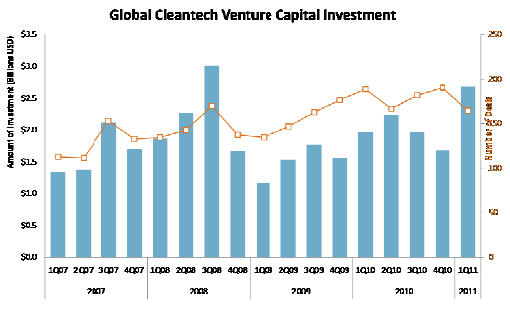
Combining cleantech with Canada’s natural resource wealth will position Canada to capture strong export markets while maximizing the value from those exports. This in turn will strengthen the Canadian economy and create the high-tech, high-value jobs of Canada’s future; jobs that cannot be easily “off shored” like many manufacturing jobs have been in the recent past.
SDTC’s experience has shown that significant private-sector capital can be mobilized for the cleantech sector, both from Canadian as well as from international investors. These investments are translating into jobs, economic activity and exports through clean technology commercialization The SD Tech Fund™, SDTC’s primary instrument to support Canada’s fledgling cleantech companies, will be fully allocated in 2011, at a time when Canada needs it most.
To continue to attract investment and secure the jobs and economic benefits of cleantech, SDTC requests the federal government to continue its support of clean technology in Canada through the establishment of a new fund, the Canadian Cleantech Accelerator Fund™ (CCAF) managed by SDTC, that will replace the SD Tech Fund™, and ensure continuity in supporting the commercialization of clean technologies in Canada, enabling further delivery of strong results.
Recommendation - The Canadian Cleantech Accelerator Fund™
The proposed $550 million Canadian Cleantech Accelerator Fund™ (CCAF) would support clean technology development, demonstration and early commercialization. The CCAF has been designed in consultation with Natural Resources Canada and Environment Canada, and has received input from other federal and provincial government entities, as well as industry. The CCAF is complementary to existing federal government programs along the innovation continuum, and focuses on the commercialization of clean technology IP.
The CCAF contributes to sustaining Canada’s economic recovery and creates quality jobs. The CCAF, at a $110M annually for 5 years, has been designed to maintain SDTC’s current level of annual investment in cleantech. As seen in the figure, the CCAF will deliver significant benefits - $5 billion of mobilized private-sector investment and $6 billion of benefits to Canadians including increased economic activity and jobs. Realistic forecasts of the benefits are calculated and given below based on the preceding results data, using the same multipliers as have already been achieved by SDTC.
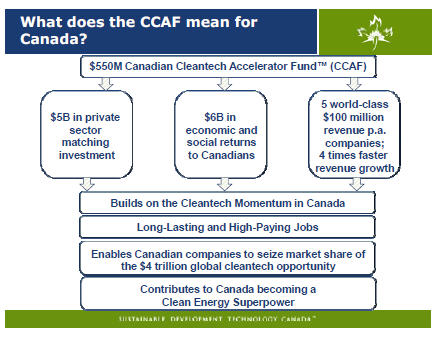
The design of the CCAF contributes to early achievement of a balanced budget. In designing the CCAF, SDTC is recommending a mechanism whereby the federal government could benefit when SDTC portfolio companies are successful. This mechanism is structured around the exercising of warrants should the portfolio company undergo a liquidity event. The monies obtained could be reinvested into SDTC or returned to the government.
Given the natural lag time between funding allocations and disbursements, in finalizing the design of the CCAF, the government has the opportunity to consider several different appropriation profiles. The continuing and constant demand on the SD Tech Fund™ in the last few years would support a straight-line appropriation model. Alternatively, a back-end loaded appropriation model would allow the government to make the necessary commitment to the CCAF in Budget 2012, thereby allowing SDTC to continue funding cleantech commercialization without a break or any loss in momentum, while flowing funds from the government to SDTC several years later. This back-end loaded model would help achieve a balanced budget without slowing the cleantech momentum in Canada nor reducing the economic benefits it brings.
The combination of monies flowing back to the CCAF from the exercising of warrants, the 13 times leveraging of private sector dollars for public dollars invested, as well as the ability to have an appropriation profile that flows funds several years after the Budget 2012 commitment all contribute to minimizing the negative impact on the deficit while maximizing the economic recovery and jobs benefits of investing in Canada’s emerging cleantech sector.